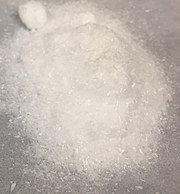Dibenzothiophene

| |

| |

| |
| Names | |
|---|---|
| Preferred IUPAC name
Dibenzo[b,d]thiophene | |
| Other names
Diphenylene sulfide, DBT
| |
| Identifiers | |
3D model (JSmol)
|
|
| ChEBI | |
| ChEMBL | |
| ChemSpider | |
| ECHA InfoCard | 100.004.613 |
| EC Number |
|
| KEGG | |
PubChem CID
|
|
| RTECS number |
|
| UNII | |
CompTox Dashboard (EPA)
|
|
| |
| |
| Properties | |
| C12H8S | |
| Molar mass | 184.26 g/mol |
| Appearance | Colourless crystals |
| Density | 1.252 g/cm3 |
| Melting point | 97 to 100 °C (207 to 212 °F; 370 to 373 K) (lit.) |
| Boiling point | 332 to 333 °C (630 to 631 °F; 605 to 606 K) |
| insol. | |
| Solubility in other solvents | benzene and related |
| Hazards | |
| Main hazards | flammable |
| GHS labelling: | |
  
| |
Signal word
|
Danger |
| H302, H311, H315, H331, H332, H410 | |
| P261, P264, P270, P271, P273, P280, P301+P312, P302+P352, P304+P312, P304+P340, P311, P312, P321, P322, P330, P332+P313, P361, P362, P363, P391, P403+P233, P405, P501 | |
| Related compounds | |
Related compounds
|
Thiophene Anthracene Benzothiophene Dibenzofuran |
Except where otherwise noted, data are given for materials in their standard state (at 25 °C [77 °F], 100 kPa). | |
| Infobox references | |
Dibenzothiophene (DBT) is the organosulfur compound consisting of two benzene rings fused to a central thiophene ring. It is a colourless solid that is chemically somewhat similar to anthracene. This tricyclic heterocycle, and especially its alkyl substituted derivatives, occur widely in heavier fractions of petroleum.[1]
Synthesis and reactions[]
Dibenzothiophene is prepared by the reaction of biphenyl with sulfur dichloride in the presence of aluminium chloride.[2]
Reduction with lithium results in scission of one C-S bond. S-oxidation occurs to give the sulfone, which is more labile than the parent dibenzothiophene. With butyllithium, this heterocycle undergoes stepwise lithiation at the 4- and 6- positions.
References[]
- ^ Teh C. Ho "Deep HDS of diesel fuel: chemistry and catalysis" Catalysis Today 2004, Volume 98, pp. 3-18. doi:10.1016/j.cattod.2004.07.048
- ^ L. H. Klemm, Joseph J. Karchesy "Dibenzothiophene from biphenyl and derivatives" Journal of Heterocyclic Chemistry, 1978, Volume 15 Issue 4, Pages 561 - 563. doi:10.1002/jhet.5570150407
Categories:
- Thiophenes